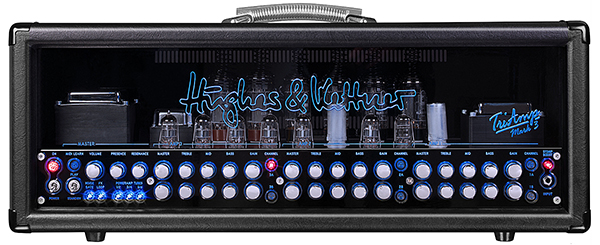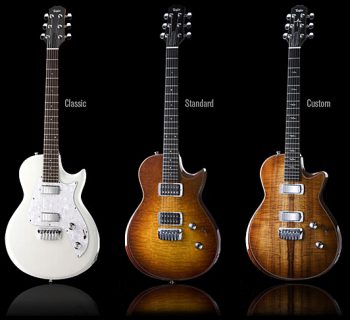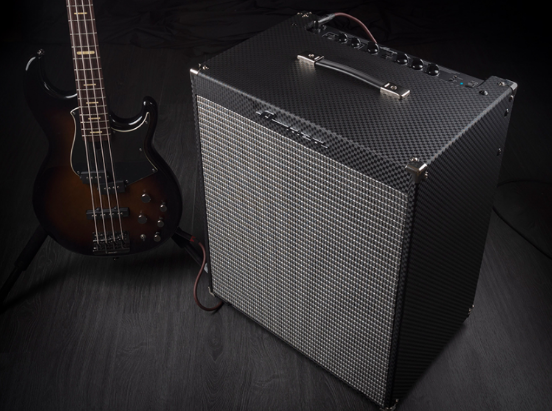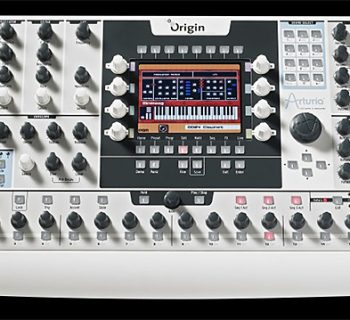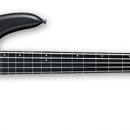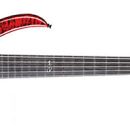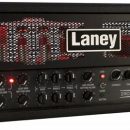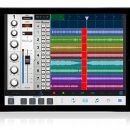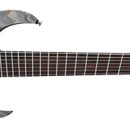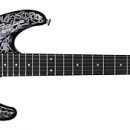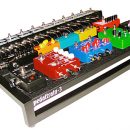 The Hughes & Kettner TriAmp Mark 3 is undoubtedly one of the most sophisticated guitar amplifiers on the market today, essentially comprised of three distinct, two-channel amplifiers in one head. As if that’s not impressive enough, add in a huge number of bells and whistles—from MIDI Control to Red Box direct recording to multiple power tube types and auto biasing and more—this amp will keep you entertained for hours, even days and years, exploring all the tonal options available at your fingertips.
The Hughes & Kettner TriAmp Mark 3 is undoubtedly one of the most sophisticated guitar amplifiers on the market today, essentially comprised of three distinct, two-channel amplifiers in one head. As if that’s not impressive enough, add in a huge number of bells and whistles—from MIDI Control to Red Box direct recording to multiple power tube types and auto biasing and more—this amp will keep you entertained for hours, even days and years, exploring all the tonal options available at your fingertips.
| Category | Value | Rating |
| Features | 20% | |
| Usability | 25% | |
| Sound | 25% | |
| Documentation & Support | 10% | |
| Price | 20% | |
| OVERALL RATING = 3.7 Stars, which earns it a WIHO Award!
3.6 stars or better: Outstanding, WIHO Award |
||
Of course, none of this amp’s tremendous capabilities would matter much if it didn’t sound fantastic… and the TriAmp Mark 3 sounds spectacular. There are amp builders who insist that the more complex an amp design; the more you lose quality of tone, of course. And then there are the Hughes & Kettner engineers who say, to hell with self-imposed limitations. For the serious guitarist in need of a broad palette of tones, unwilling to compromise quality for functionality, the Hughes & Kettner TriAmp Mark 3 amp definitely delivers the goods and earns a rightful place among the finest amps made.
Features
The Hughes & Kettner TriAmp Mark 3 is manufactured in Germany, and it presents a foreboding appearance at first glance—there are a lot of knobs! But as you’ll learn soon enough, it’s extremely user-friendly.
When you fire up the amp, it glows with a gorgeous blue backlight behind the knobs and glass faceplate, which reveals a pretty exhaustive array of tubes: four 6L6 power tubes, two EL34 power tubes, seven ECC83 tubes for preamps and the effects loop buffer, one 12AX7A-C preamp tube, and a 7025/E83CC input tube. By selecting various combinations of 6L6 and EL34 power amp tubes, the Triamp Mark 3 is capable of generating an output of up to 150 watts.
The circuit design incorporates three, two-channel amplifiers with sounds described as follows:
| Amp 1: | Amp 2: | Amp 3: |
| ‘50s California Clean ‘60s British Clean |
‘70s British Lead ‘80s Brown Sound |
‘90s California High Gain Modern-Day High Gain |
What looks like one hundred knobs is actually pretty clear when you take a look, as the six fully independent channels feature identical sets of controls: Master, Treble, Mid, Bass and Gain. Below, you're looking at two channels:

The Master section of the amplifier located to the left of the channel controls contains a set of global controls including: Power On/Off and Standby switch, MIDI Learn button (to store your various settings), master volume control, noise gate On/Off (control on the rear), effects loop On/Off push buttons, Presence, Resonance, and power tube selection push buttons. The status of most of these controls, along with your choice of amp channel, can be saved as MIDI-selectable presets, and the amp even includes a capable MIDI foot controller for those of you without the need for big rigs.
The amp also includes a selectable Boost circuit, which acts just like a boost pedal placed in front of the preamp section of your amp.
Turning to the rear of the amp provides just as much eye candy as the front of the amp (thankfully, fewer controls). The Speaker section contains a familiar assortment of speaker connections for one or two cabinets with various 4, 8 or 16ohm settings.

Next to the speaker section is the Red Box AE feature, which is the latest generation of Hughes & Kettner’s famous cabinet simulation technology. It includes an XLR connection for direct connection to a PA system or recording interface, and switches to customize the direct sound. Having Red Box technology built directly into the amp is a great benefit as you can send a consistent sound to the front-of-house mix desk at all of your shows without relying upon the haphazard placement of mics in front of your cabinet.
The next feature (most amazing) is the Tube Safety Control (TSC), which provides tube performance monitoring and continuous/automatic biasing. Each power tube has a dedicated LED that indicates the operating condition of the tube, with a simple-to-follow key printed directly above the lights.
The remaining features on the back panel include MIDI In and Out/Thru, a variable control for the noise gate response, and an effects loop that can operate in either series or parallel. The loop has a level control and -10db cut button, too!
The Master Insert section is an interesting feature, as it’s basically an additional utility loop. The Preamp Out jack is always active, and you could patch a tuner into it and call it a day. Or, you could use that to send the preamp signal to another power amp for a wet/dry type of setup. Or, you could patch a volume pedal between this jack and the associated Power Amp In jack, for volume control in between the preamp and power amp section.
Last but not least, there is an adjustment dial for the brightness of the blue back lighting.
The Hughes & Kettner TriAmp Mark 3 comes with the TSM-432 MIDI foot controller, which controls all functionality within the amp.

The EU version of the Hughes & Kettner TriAmp Mark 3 also includes AES, an energy saving feature that will shut the amp off after 90 minutes of inactivity.
Usability
The Hughes & Kettner TriAmp Mark 3 is intimidating from first sight, but after a brief review of the owner’s manual and quick set-up to get acquainted with the basics, it was a breeze to start navigating through its vast landscape.
The layout of the TriAmp Mark 3 makes it remarkably easy to operate, and we sailed through the basics of dialing in some tones and switching channels within a matter of minutes. We have used other amps with four or more channels, and the Mark 3 is among the easiest—if not the easiest, to comprehend.
The key to this amp’s ease of use lies in the fact that all channels have a complete sets of tone control knobs, independent from the other channels. Some other multi-channel amps have channel volume in one place, gain control in another, then shared tone controls somewhere else, which can take a while to master. We loved the straightforward approach on display here, with no shared tone controls other than a few global settings that we’ll get to.
The globally shared controls are easily identified by their left side grouping on the faceplate of the amp. The Master Volume control here is the amp’s main volume control, while each of the six channels has its own volume knob. This made it easy to balance levels across all six channels. Presence and Resonance are also set via master controls.
Another nice touch: There is a pushbutton to the right of each channel that lets you change channels without the use of any footswitch, handy when you’re just sitting in front of your amp dialing in sounds.
So what about all of those tubes? After we selected a channel on the amp, it was a simple matter of pressing a few pushbuttons underneath the global controls to select which pairs of tubes were in use. A few other buttons let us choose whether or not the noise gate was active on a channel, and whether or not to engage the effects loop. Holding the MIDI Learn button a few seconds stored our configurations for each of the channels, but as we’ll get to later, there is memory for far more presets than just the six basic channel settings.
The noise gate worked particularly well. We found that setting the gate’s control (on the rear of the amp) to 12:00 provided gating that worked beautifully to control noise and not interfere with the decay of our notes. Adjusting +/- from the 12:00 midpoint changed both the attack and the closing gate relationship.
The TSM-432 MIDI foot controller connected to the head via a familiar 7-pin DIN cable (included), which supplies power to the foot controller without the need for an external power supply or wall wart.
The matching Hughes & Kettner TSM-432 footswitch provides control over the amp in two separate modes: Preset and Stompbox. Sound selections could be saved to 128 MIDI presets or we could use the controller in Stompbox mode, where it simply controlled the six amp channels and Stomp Boost function. The Preset mode worked great: select a bank, then press one of the four lettered footswitches, choose our channel and various switch settings on the amp, then press the MIDI learn function. That’s it! Preset stored.
As an alternative to the TSM-432 foot controller, any standard MIDI foot controller will work, so we connected our TC Electronics G-System via MIDI for amp control, while also connecting its audio ins/outs to the effects loop for our sound effects. Just like with the H&K controller, assigning a specific amp channel to a preset on the G-System was as simple as selecting the desired preset on the G-System first, then making our channel/tube/loop/gate settings on the TriAmp Mark 3, and then hitting the MIDI Learn button to save the settings. You barely have to comprehend anything about MIDI to take advantage of these capabilities in the amp, and thus have access to an incredible variety of sounds with direct footswitch access.
For those of you with more advanced MIDI control needs, all of the TriAmp Mark 3’s features can be assigned to MIDI continuous controller (CC) values. So in addition to saving presets, we were also able to assign features like direct control of the noise gate, stomp boost, and more to specific footswitches on our G-System. As if this isn’t cool enough, you can even assign the panel brightness to a continuous controller, and you can also set a controller for the amp’s Mute feature, which otherwise requires a trip to the front panel’s physical Standby switch.
While testing our review model early on, we experienced a faulty power tube issue, and thus we unexpectedly had a chance to explore use of the fantastic Tube Safety Control feature. TSC continuously performs an error diagnosis of each tube. If necessary, the TSC will shut down a defective tube to avoid any additional harm (or total failure) to the amplifier. Even though a tube may have failed, you can continue to play the amp utilizing the remaining tubes—handy if a tube happens to blow in the middle of a performance.
We were easily able to review the TSC (Tube Safety Control) on the rear of the amp and identify 1) that there was a power tube issue, and 2) identify exactly which power tube was faulty. Installing a replacement tube was a very simple procedure thanks to the Mark 3’s auto-biasing feature. We simply installed the tube, placed the Standby switch in the Play position, turned the amp On, and waited a few minutes.
Another advantage of the TSC and its associated auto biasing is that you have the option to install different tubes such as substituting KT88s for the EL34s, or to experiment with different versions of 6L6s from different manufacturers, and so on.
One engineering flaw was uncovered in our testing, however: the handle design. Luckily, no damage occurred, but we had a minor mishap that could have been devastating. The connection pins that secure the handle to the anchored brackets on the top of the head have press fitted/compression end caps on each end. In our situation, one of the end caps popped off and allowed the handle to disconnect from the retaining bracket. An easy fix and better solution would be to replace the simple end caps with a true nut and bolt configuration. Hopefully H&K will remedy this trivial—yet important—concern.
Sound 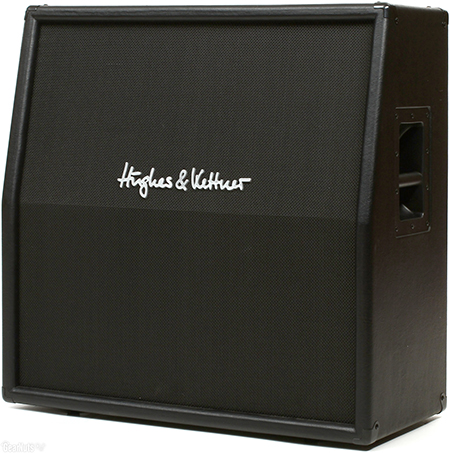
Sure, you can have a ton of channels and plethora of knobs, but that doesn’t guarantee a sea of great tone and functionality. When it comes to the Hughes & Kettner TriAmp Mark 3, this amp lives up to all expectations perceived on first visual impressions. It’s a beast, and it comes to the ring with one thing in mind: dominance.
This is an amp that sounds fantastic, whether you seek pristine cleans or vintage clean with a little breakup, classic hard rock crunch, or modern prog metal tones. Players in need of a diverse range of tones, and those who crave easy effects integration, will find that with the Triamp Mark 3, you can have your cake and eat it, too… assuming you can afford to buy the cake.
Compared with other modern, multi-channel, high-gain amps, the playing response from the TriAmp Mark 3 is similar to what we’ve found playing various high-gain amps of a similar pedigree, such as the ENGL Special Edition E670 or Ironball II, Bogner Ecstasy, or Fuchs TDS amps. It can respond as tight and fast as you need (particularly on the modern day, high gain circuit), but overall, the amp is a bit more forgiving than many of its peers, remarkably playable, and well suited to your mainstream pop, rock, blues, and hard rock excursions.
This is an amp that encourages you to play with a higher caliber of proficiency, and it rewards your effort with splendid tone… and it never makes you struggle to find that tone. In fact, from the very first five minutes we spent with the amp, we experienced a treasure trove of fantastic sounds. If you’ve ever played certain amps that take finesse to dial in their best tones and really nail the sweet spot, we’re happy to report that in the TriAmp Mark 3, you won’t even break a sweat hitting your mark with this amp.
Finesse players and the prog rock/fusion crowd will appreciate the clarity and note separation on tap. Even with plenty of high-gain mayhem, we could still hear the nuances of our complex chord voicings.
With an amp design full of sought-after tones from both yesterday and today, we put our fancy signature models and boutique guitars aside and focused on the classics, dialing in our sounds playing traditional Gibson Les Paul and Fender Stratocaster guitars. We paired the head with a Hughes & Kettner TC 412 A60 cabinet, which includes four custom RockDriver Classic 60 speakers, as well as with an ENGL Pro 412 and 212 cabinet, each featuring Celestion V30 speakers.
Whether you favor single-coil or humbucker pickups, this amp provides shimmering clean tones and subtle warm to over-the-top aggressive, high-gain stages.
As specified by Hughes & Kettner, the TriAmp Mark 3 contains three dual-channel amps, each having its own tonal character. Obviously, these are just starting points for reference in order to understand the amp’s intended voice. We took a lengthy journey through each channel to see how they measured up, always considering our power amp tube choice both for obtaining the intended tone as well as for creating unique tones. For example, if you’re after a classic Marshall tone, you use EL-34 tubes. If you’re going for more of a Mesa/Boogie Rectifier tone, you go for the 6L6 power tubes. As we said… starting points…
Amp 1/Channel A: Sparkling ‘50s California Clean
True to its description, this channel provided some of the best cleans we’ve heard in a long time. When paired with the Stratocaster, the amp provided an extremely well-rounded tone with plenty of clarity, depth, and spank. Turning the gain up provided additional definition. And with the Gain set at 10, it provided just a slight hint of overdrive (a little moreso with the LP.) There’s nothing but crisp, clear, round tones coming out of this channel.
Amp 1/Channel B: Chimey ‘60s British Clean
Still characteristically similar in tonal bloom as with Amp 1/Ch A, Channel B’s gain stage has that ever-so-slight British grit throughout. Sweeping through the Gain stage covers everything between an ever-so-slight hint of silky overdrive to a very light and mild distortion with smooth harmonics. It delivered beautifully balanced tone with shimmering overtones.
Amp 2/Channel A: Classic ‘70s British Lead
This channel, set up for overdrive tones, provides all the classic rock tones of the seventies. Reminiscent of that era, the tone provides an open British style overdrive comparable to a slightly overdriven Marshall. The tone is very open sounding while providing excellent dynamics for lead or chord work.
Amp 2/Channel B: Brown ‘80s British Lead
Escalating from the previous channel, Channel B remains true to the British sound, but the gain stage provides additional harmonics and sustain reminiscent of the ‘80s era Marshall sound. We found this channel provided gain settings from slightly gritty to fat overdrive. And at 10, the gain was perfect for those singing leads with long lasting sustain, full of smooth, blooming harmonics. The humbuckers in the Les Paul gave us a little more edge, but the Strat was no slacker, and provided that ‘80s edge we all crave.
Amp 3/Channel A: Classic ‘90s American High Gain
This amp section really takes the gain stages into the stratosphere. Reminiscent of classic ‘90s high-gain tone, it provides defined articulation in response to your picking style/technique, and it also reacts well to a variety of volume settings on your guitar while maintaining crispness and clarity. Even though this is a “high gain” channel, you can still roll off the gain to get a smooth, silky overdrive dialed in to taste.
Amp 3/Channel B: Modern Day High Gain
This channel sounds just as intended, living up to its description by providing endless amounts of high gain, allowing everlasting sustain and effortless playing through sweep picking, hammer-ons, and two-hand tapping extravaganzas. But where it really shines is with drop D tuning or the use of a 7-string guitar. We plugged in an Ibanez RG7 for a spin and unleashed a beast!!! This channel provided all the growl and low-end girth we could ever desire. The clarity of every note, high or low, remained pronounced and clear. And with some tweaking of the Resonance knob, there was more than enough chug and punch out of the low end. Prog metal players will be especially happy with this amp setting.
The salt and pepper of the amp, Presence and Resonance controls, provide excellent enhancements to your overall tone. The Presence control was comparable to most amps in the 12:00 position. Slight adjustment left or right provided a more covered or open tonal characteristic as well as modifying the amp’s initial attack. The Resonance control also uses 12:00 as the normal setting and provided excellent coloring for softer resonance at lower settings or tighter, punchier low-end definition when increased.
As mentioned earlier, the noise gate worked quite well, and even without it, this is not a noisy amp, even when playing the high-gain voicings. And the effects loop worked great both with the G-System we mentioned previously, as well as when connecting a pedalboard full of effects pedals running through a Rocktron Patchmate Loop 8 Floor audio looper.
Now let’s play a little bit quieter… or perhaps we’ll just be direct with you. The Hughes & Kettner Red Box was one of the first DI’s for guitar amps, and was pretty much the industry standard for many years. The latest technology found in the Hughes & Kettner TriAmp Mark 3 is the Red Box AE, which adds Ambience Emulation to the famous, simulated speaker output. Though we prefer some of today’s more advanced cabinet simulation solutions, the Red Box AE sounds good, and it responds very well when patched directly into a mixing or recording console. We connected the DI output to our Pro Tools setup, and the response was actually quite impressive, providing great clarity and transfer, as if we were playing through a miked cabinet. The low-end cut and Cabinet Mode 2 provided ample setting options to achieve quality tones.
Video courtesy of Hughes & Kettner |
Documentation and Product Support
The user’s manual for the Hughes & Kettner TriAmp Mark 3 is very well detailed and provides everything you need to know about this amplifier. All features are very well documented. Even novices scared by the idea of a MIDI foot controller will find everything explained in a super, easy reading manner.
Price
The Hughes & Kettner TriAmp Mark 3 Head (MSRP $4,999) sells for approximately $4,000, including the TSM-432 MIDI foot controller and a padded head cover. The matching TC412 A60 4x12 cabinet will set you back another $1,100.
Considering you’re effectively getting three, two-channel amps in one box, with integrated MIDI control (and a fully functional MIDI foot controller) to boot, the TriAmp Mark 3 amp delivers a solid value.
Some amp purists may stick to their notion that multi-channel amps are too complex, hard to service, and not as good tone-wise as more straightforward amp designs. But we see the arguments being akin to a classic car restoration garage professing that a modern BMW or Porsche is too complex to deliver the same overall experience. We say, No, they just require a different service center with the right set of tools and expertise. But given the high quality of engineering on display here, and the fantastic, active tube monitoring (and biasing) technology, you’ll probably spend less time dealing with those folks, anyway.
Contact Information
Hughes & Kettner
www.hughes-and-kettner.com
| Evaluation Short-List |
|

